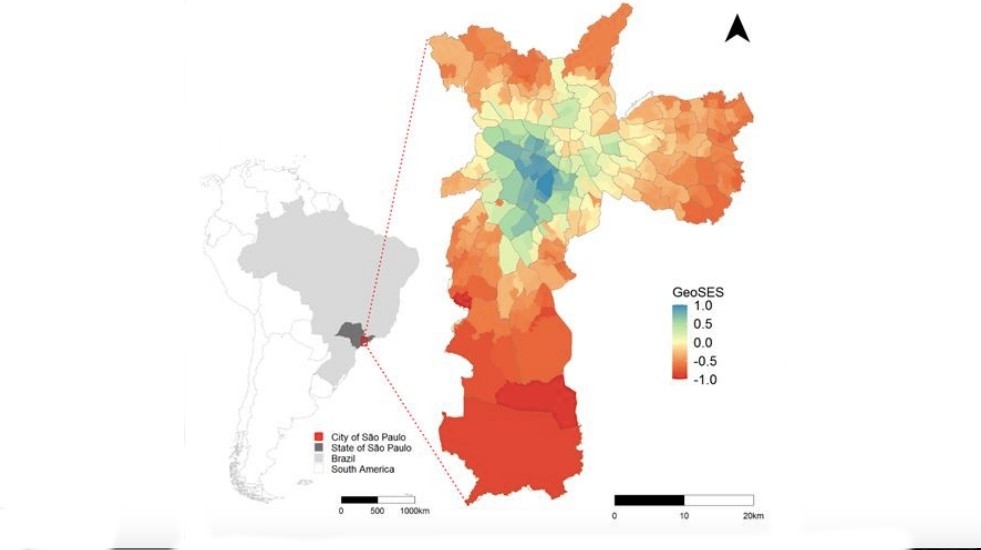


Map showing socio-economic levels of administrative districts in São Paulo City according to the GeoSES index used in study. Areas in red and blue are lowest and highest on scale respectively (image: arXiv:2008.02322v1)
Published on 03/18/2021
By Karina Toledo | Agência FAPESP – Inhabitants of São Paulo City in districts such as Parelheiros or Capão Redondo, located on the outskirts of Brazil’s largest city, ran a 50% greater risk of dying from COVID-19 between March and June than people living in downtown areas and in high-income neighborhoods such as Vila Mariana or Moema.
The analysis, based on data from the Brazilian Health Ministry’s Mortality Information System (SIM), was produced with support from FAPESP by researchers at the University of São Paulo (USP). Their findings are published on the e-print platform arXiv in an article that has not yet been peer-reviewed.
“The difference between lower- and higher-income districts of São Paulo in terms of risk of death could be as much as 66% in the period analyzed if suspected COVID-19 deaths often not confirmed for lack of testing were included,” Francisco Chiaravalloti-Neto, a professor in USP’s School of Public Health (FSP) and last author of the article, told Agência FAPESP.
As suggested by previous research, the mortality pattern observed in this study changed significantly during the period of several months. Until mid-April, the risk of dying from complications of the disease in São Paulo was higher in downtown and higher-income districts. The trend reversed in epidemiological week 16 (April 12-18), and from then on the risk was lower for the relatively well-off.
“Our analysis also showed that COVID-19 deaths in São Paulo City peaked in epidemiological week 20, which was May 10-16,” Chiaravalloti-Neto said.
Methodology
To reach the conclusions described in the article, the researchers correlated confirmed and suspected COVID-19 death records with socio-economic data for places of residence. SIM data was extracted from two city databases: TabNet, and e-SIC.
“The e-SIC database was less up to date but provided data on the methodology used by IBGE [Brazil’s national census bureau] to weight the areas of residence for these deaths, which we correlated with the COVID-19 mortality data. IBGE’s survey data also covers educational attainment and income, among other variables,” Chiaravalloti-Neto said.
Income levels were estimated using GeoSES, a socio-economic index specially developed for health research by geographer Ligia Vizeu Barrozo, a professor at USP and penultimate author of the article. The index ranges from minus 1 to plus 1 based on income, education, segregation, access to resources, etc.
“The risk of death rose more sharply in outlying areas of the city as the weeks went by,” Chiaravalloti-Neto said. “For the entire period analyzed, a rise of one unit in the GeoSES index [from -1 to 0, for example] corresponded to a 25% decrease in the risk of death based on confirmed COVID-19 deaths, and 33% if suspected COVID-19 deaths were included.” By the same logic, a rise of two units in the index, from one extreme of the scale to the other, would correspond to decreases of 50% and 66% respectively.
“This kind of analysis showing the weekly evolution of mortality can help local government decide where to invest to combat the disease,” Chiaravalloti-Neto said. “In addition, by pinpointing areas with a surplus of suspected COVID-19 deaths it can be used to detect possible barriers to controlling the outbreak such as insufficient diagnostic testing, difficulties in obtaining guidance or resources for personal and collective protection, and lack of access to hospitalization and treatment. The study emphasizes the need to recognize and address the close correlation between the risk of death and social determinants, including living conditions.”
The article “Spatiotemporal dynamic of COVID-19 mortality in the city of São Paulo, Brazil: Shifting the high risk from the best to the worst socio-economic conditions” can be read at: arxiv.org/abs/2008.02322.
Source: https://agencia.fapesp.br/34345